Throughout Preservation Month we’re honoring Maryland’s heritage and recognizing the positive impact historic preservation has on communities across the country. Today we’re sharing ten of our favorite historical places in the state. Join us on our road trip to discover the rich history that Maryland has to offer!
Start in Southern Maryland
- Harriet Tubman Underground Railroad National Historical Park – Church Creek
The Harriet Tubman Underground Railroad National Historical Park tells the story of the incredible Harriet Tubman. Tubman was an escaped enslaved person, abolitionist, suffragist, conductor on the Underground Railroad, and nurse/spy for the Union during the Civil War. She alone rescued 70 enslaved people during her lifetime. Visitors to this National Historical Park can tour the Harriet Tubman Museum, explore the Blackwater National Wildlife Refuge, or travel along the Captain John Smith Chesapeake National Historic Trail.
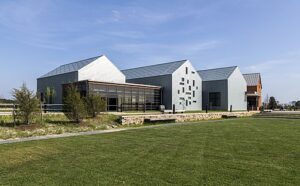
Photo Courtesy of Wikimedia Commons.
- Historic St. Mary’s City – St. Mary’s City
Historic St. Mary’s City is a place of living history. St. Mary’s was Maryland’s first capital; it is where the Europeans arrived on the Ark and Dove ships, settling the first colony in Maryland. Historic St. Mary’s City is dedicated to telling the story of the Europeans, Indigenous Peoples, and enslaved persons that once inhabited these Maryland lands. Visitors can explore the Brick Chapel, the Town Center, the Mackall Barn, The Struggle for Freedom Exhibit, or the Woodland Indian Hamlet. There is much to learn at this historic site.

Reconstructed 1667 Brick Chapel. Photo Courtesy of Wikimedia Commons.
Near Washington D.C.
- Surratt House Museum – Clinton
The historic Surratt House and Tavern, constructed in 1852, is the oldest building in Clinton, Maryland. As the family home and business of John H. Surratt, Sr., his wife Mary, their three children Isaac, Anna, and John, Jr., and an enslaved community of nine individuals including, Rachel Semus, Henry and Alfred Hawkins, James Butler, George, Jane, and three unidentified children, the site gained national notoriety for its connection to the Assassination of President Abraham Lincoln on April 14, 1865. In 1974, the structure opened its doors to the public as an historic house museum. Today, the Surratt House Museum staff utilizes the structure and its stories to interpret the legacies of the American Civil War, Lincoln’s Assassination, and Reconstruction.
Recently, the museum underwent a preservation project to rehabilitate and restore the siding of the structure. Working with M-NCPPC Historic Preservation Maintenance Unit and Worcester Eisenbrandt, Inc., the siding was repaired and the original color (based on a microscopic paint analysis) was applied to all of the siding. This work returns the building to a weathertight and sustainable state and restores the original appearance of the building c. 1852.
Surratt House Museum is open for self-guided tours Thursday-Sunday from 11:00 am – 3:00 pm.
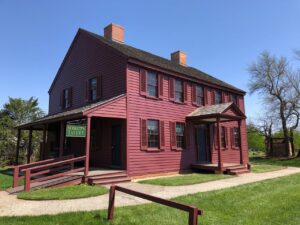
Credit: M-NCPPC.
- Frederick Douglass Museum and Cultural Center – Highland Beach
Also known as Twin Oaks, this museum and cultural center was the location of the summer cottage built for Frederick Douglass in 1895. The museum’s goal is to promote a greater understanding and appreciation of the life and work of Frederick Douglass and his family. The house contains items from Frederick Douglass’ estate. Douglass’ children and grandchildren vacationed here and enjoyed summers on the bay. The house was renovated in the 1990s and added to the National Register for Historic Places in 1992. The museum received a Heritage Fund grant from Preservation Maryland in 2017. Highland Beach in Anne Arundel County, Maryland was the first incorporated African American municipality in Maryland.

An Afternoon in Baltimore
- Fort McHenry – Baltimore
Next is the Fort McHenry National Monument and Historic Shrine. This military fort was constructed during the American Revolution and played a crucial role in the War of 1812. During the Civil War, the site was used as a prison, and during WWI, it served as a hospital. Fort McHenry became a monument and shrine of the National Park Service in 1939. Visitors to the site today can tour the Star Fort or walk the SeaWall Trail.
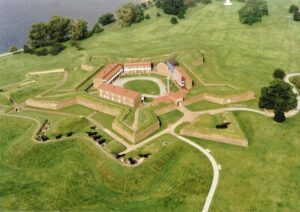
Photo Courtesy of Wikimedia Commons.
- USS Constellation – Baltimore
The USS Constellation is a museum ship and National Historic Landmark. It was built in 1854, the last sail-only warship designed and constructed by the United States Navy. Before serving in the American Civil War, the ship toured with the Mediterranean Squadron. As part of the Historic Ships of Baltimore, you can learn about the history of the USS Constellation and “experience” life at sea by touring the ship.
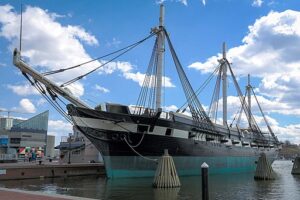
Photo Courtesy of Wikimedia Commons.
- The Star Spangled Banner Flag House – Baltimore
In connection with Fort McHenry, we have The Star Spangled Banner Flag House, a National Historic Landmark. It is in this home that Mary Young Pickersgill, a nineteenth-century female entrepreneur, sewed the flag that inspired the National Anthem, The Star-Spangled Banner. Her flag flew at Fort McHenry during the Battle of Baltimore (September 13-14, 1814). This battle turned the tide of the War of 1812. Francis Scott Key saw the flag flying and wrote a poem about it, and his poem was later put to music. The house, which was built in 1793, tells the story of the women who helped Pickersgill craft the famous flag.
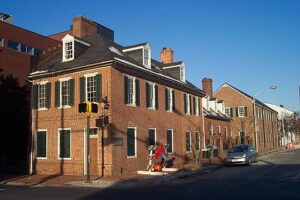
- B&O Railroad Museum – Baltimore
The B&O Railroad Museum houses some of the oldest American railroad collections in the country. Exhibits contain locomotives, rolling stock, historic buildings, and small objects from the rail line. The B&O Railroad was chartered on February 28, 1827 and operated from 1828 to 1987. The museum even contains its own archives and library. The library has the Junior Junctions program, where children can attend storytimes to learn about the history of the railroad in fun and engaging ways.
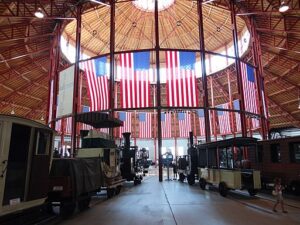
Photo Courtesy of Wikimedia Commons. Esther Westerveld.
Traveling North…
- Hampton National Historic Site – Towson
Located in Towson, Maryland, Hampton is a National Historic Site. The plot encompasses a historic house and 63 acres of land. Colonel Charles Ridgely originally bought 1,500 acres of the land in 1745. Today, the Hampton Mansion tells the story of those who lived there over the centuries, both the wealthy plantation owners and the enslaved persons that toiled on the land. Hampton Mansion is home to exquisite architecture, fine arts, photographs, exhibits, and much more.

Photo Courtesy of Wikimedia Commons.
- Fort Frederick State Park – Big Pool
Finally, we have Fort Frederick State Park. Fort Frederick is one of the largest fortifications built by English colonists in North America (the stone wall is 18 ft. high and the fort’s exterior lines are 355 ft. apart.) This state park preserves the history of the fort, which played a crucial role in the French and Indian War and the American Revolution. Ever since the Civil War, various groups have worked to maintain the fort and keep its stone walls from crumbling. At Fort Frederick State Park, there are performances by volunteer reactivated military units, guided tours, and places to hike and camp.
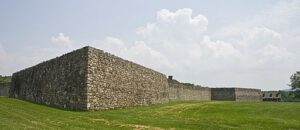
Photo Courtesy of Wikimedia Commons.

